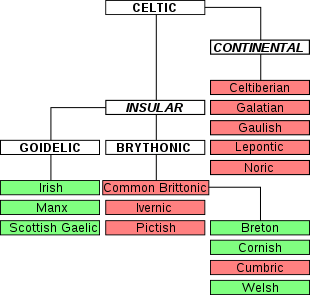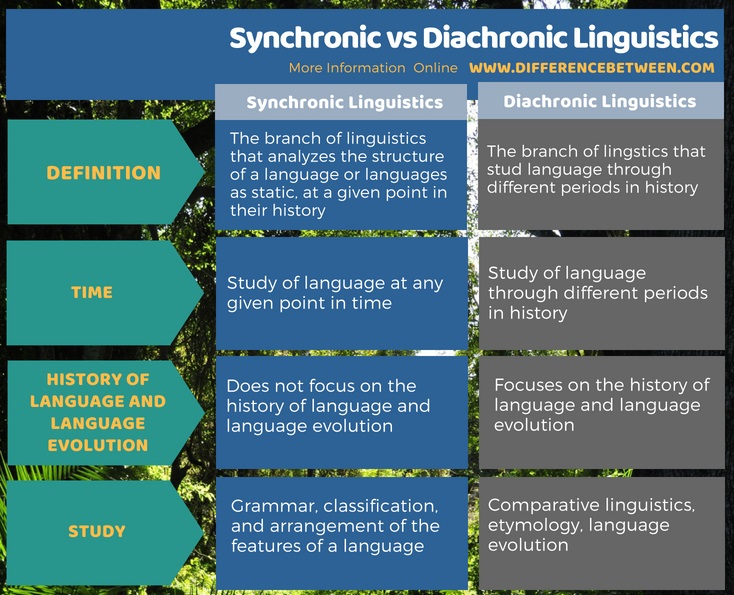Difference Between Synchronic and Diachronic Linguistics
Table of Contents
The key difference between synchronic and diachronic linguistics lies in the viewpoint used to analyze these two branches of linguistics. Synchronic linguistics, also known as descriptive linguistics, is the study of language at any given point in time while diachronic linguistics is the study of language through different periods in history.
Synchronic linguistics and diachronic linguistics are two main divisions of linguistics. The Swiss linguist Ferdinand de Saussure introduced these two branches of linguistics in his Course in General Linguistics (1916). Overall, synchrony and diachrony refer to a language state and to an evolutionary phase of language.
CONTENTS
1. Overview and Key Difference
2. What is Synchronic Linguistics
3. What is Diachronic Linguistics
4. Side by Side Comparison – Synchronic vs Diachronic Linguistics in Tabular Form
5. Summary
What is Synchronic Linguistics?
Synchronic linguistics, also known as descriptive linguistics, is the study of language at any given point in time, usually at present. However, this point in time can also be a specific point in the past. Thus, this branch of linguistics attempts to study the function of language without reference to earlier or later stages. This field analyzes and describes how language is actually used by a group of people in a speech community. Thus, involves analyzing grammar, classification, and arrangement of the features of a language.

Figure 01: Syntactic Tree
Unlike diachronic linguistics, it does not focus on the historical development of language or language evolution. Ferdinand de Saussure introduced the concept of synchronic linguistics at the beginning of the twentieth century.
What is Diachronic Linguistics?
Diachronic linguistics basically refers to the study of language through different periods in history. Thus, it studies the historical development of language through different periods of time. This branch of linguistics is the diachronic linguistics. Main concerns of diachronic linguistics are as follows:
- Describing and accounting for observed changes in particular languages
- Reconstructing the pre-history of languages and determining their connection, grouping them into language families Developing general theories about how and why language changes
- Describing the history of speech communities
- Studying the history of words

Figure 02: Language Family Tree
Furthermore, comparative linguistics (comparing languages to identify their historical relation) and etymology (study of the history of words) are two main sub-fields of diachronic linguistics.
What is the Difference Between Synchronic and Diachronic Linguistics?
Synchronic linguistics is the study of language at any given point in time while diachronic linguistics is the study of language through different periods in history. Thus, the main difference between synchronic and diachronic linguistics is their focus or viewpoint of study. Diachronic linguistics is concerned with language evolution while synchronic linguistics is not. Moreover, the latter focuses on subjects such as comparative linguistics, etymology and language evolution while the former focuses on grammar, classification, and arrangement of the features of a language.

Summary – Synchronic vs Diachronic Linguistics
The difference between synchronic and diachronic linguistics depends on their focus of study. This is because the former looks at language at a given period of time while the latter looks at language through various periods in history. However, both branches are important in order to study a language properly.
Reference:
1.Nordquist, Richard. “What Is Synchronic Linguistics?” ThoughtCo, ThoughtCo. Available here
2.“Historical Linguistics.” Wikipedia, Wikimedia Foundation, 3 May 2018. Available here
Image Courtesy:
1.’The vase broke-Syntactic Tree’By Eliachow – This tree is a representation of the example given in Schäfer. [1]^ Schäfer, Florian. 2009. “The Causative Alternation.” Language and Linguistics Compass 3.2: 641. Print.gb (CC BY-SA 3.0) via Commons Wikimedia
2.’Celtic language family tree’By Elevatorrailfan (CC BY-SA 4.0) via Commons Wikimedia
ncG1vNJzZmivp6x7pbXFn5yrnZ6YsqOx07CcnqZemLyue8OinZ%2Bdopq7pLGMm5ytr5Wau26%2F2Keaoaqfo7akecCnm2acmZawqb7Op6CcZZyeu6jByKyropujZA%3D%3D